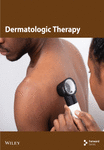Effect of Night Peeling With Azelaic Acid on Mature Facial Skin Parameters After 28 Days of Use: Preliminary Report
Abstract
The aim of this study was to determine the effect of night peeling with azelaic acid (AA) on the parameters of mature facial skin after 28 days of use. The sample consisted of 28 participants (six participants did not complete the study for reasons unrelated to cosmetic intolerance), aged 40–68 years old, including both men and women, with dry and/or normal skin types, closed comedones, and visible signs of aging. The study lasted 28 days, during which all participants were evaluated before and after the treatment with the night peeling containing AA. The results showed that not all parameters changed significantly. Significant changes was observed in the skin moisture level (increased by 4%), skin elasticity (improved by 11%), and wrinkle length (reduced by 4%). In addition, it reduced wrinkle count by an average of 15%, wrinkle volume by an average of 8%, and wrinkle area by an average of 5%. These findings indicate a successful response to the night peeling treatment with AA. However, the study was relatively small in size and could be extended to include more subjects and investigate the use of the product over a longer period of time.
1. Introduction
Skin aging processes occur equally in men and women through both internal and external mechanisms, which contribute to a progressive loss of skin integrity [1]. Internal and external aging processes are distinguished. Internal aging of the skin is primarily genetically determined. The first signs include the accumulation of reactive oxygen species (ROS) as a byproduct of cellular metabolism [2]. This is followed by a reduction in the epidermis, leading to the deterioration of skin structure and function [1].
Extrinsic skin aging begins earlier and is caused by exposure to factors such as sunlight, air pollution, lifestyle, and poorly balanced nutrition [3].
Changes in the skin occur at all structural levels, modifying its appearance. Initially, these changes are invisible to the naked eye. They begin with modifications in the epidermis, the dermal–epidermal junction (DEJ), and degradation of the dermal extracellular matrix (ECM), affecting elastin and collagen fibers [3, 4]. Furthermore, the breakdown of this fiber network leads to surface wrinkles, while deep wrinkles are caused by the loss of fibrillin and deposits of poorly organized elastin [5]. A decreased level of hyaluronic acid, proteoglycans, and glycosaminoglycans contributes to a loss of tone in the ECM and disruption of cell–matrix interactions [3]. Consequently, the epidermis becomes thinner, leading to cutaneous dryness, visible pores, redness, small actinic keratoses (scaly, rough patches of skin), and more pronounced pigmentation [6].
As aging progresses, the thickness of the stratum corneum slightly increases while the epidermis thins. This causes the dermal tissue and hypodermis to provide less protection against mechanical stimuli [7].
When discussing visible changes in facial skin, it is essential to highlight signs of aging such as wrinkles, dark spots, loss of elasticity, tissue ptosis, and undesired hair growth [8–10]. Wrinkles form as changes begin at the epidermal level, where there is a decrease in the quality of keratinocyte differentiation, reduced expression levels of filaggrin and desmoplakins, leading to a reduction in epidermal thickness [8]. Dark spots are associated with the process of photoaging, which affects pigment regulation in the skin [11]. Mohiuddin notes that ultraviolet radiation (UVR) increases melanocyte proliferation, the number of dendrites, and the transfer of melanosomes to keratinocytes. These pigmentary changes may include growths such as ephelides, melasma, seborrheic keratoses, and lentigos [12].
The structural stability of the epidermis, dermis, and hypodermis is linked to the loss of skin elasticity. This depends on the integrity of the ECM, particularly collagen and elastin, as well as normal cellular proliferation and adequate barrier function, including lipid production and skin hydration [5]. According to Two and colleagues, aging skin becomes drier due to decreased secretion from sebaceous and sweat glands. In addition, disruptions in the differentiation of unsaturated fatty acids, such as oleic acid in sebum, combined with a reduced amount of collagen, contribute to pore dilation [13].
Many internal and external factors can affect skin properties, leading to changes in skin appearance, which can, in turn, impact self-esteem and overall quality of life, including social interactions [3]. As a result, many individuals seek ways to improve their skin’s appearance, making this a highly sought-after area globally, with the antiaging cosmetic industry steadily growing. There are increasing options for antiaging treatments, dermatological tests, and cosmetic products [14]. One popular remedy for combating skin aging is azelaic acid (AA), a common active ingredient in many cosmetic formulations.
AA is a naturally occurring, plant-sourced saturated dicarboxylic acid with a nine-carbon straight-chain structure, found in wheat, rye, and barley [15, 16]. It can be synthesized from substrates such as longer-chain dicarboxylic acids and is also produced during processes like oleic acid metabolism [17]. The cosmetic and pharmacological applications of AA have been approved by the U.S. Food and Drug Administration (FDA) and European Medicines Agency (EMA) for external use [18]. AA possesses antibacterial and anti-inflammatory properties, reducing proinflammatory cytokines such as IL-1, IL-6, and TNF-α [19]. It can also inhibit mitochondrial metabolism and microbial protein synthesis [16]. These properties contribute to the modification of follicular epidermal hyperproliferation and inflammation, making AA effective in the treatment of skin pigmentation issues and melasma [20].
AA inhibits tyrosinase, the primary enzyme involved in melanin synthesis [21]. By inhibiting the reduction of extracellular chemical compounds, it redirects electron flow toward oxidized thioredoxin, acting as a tyrosinase inhibitor and preventing melanin biosynthesis [17]. Consequently, a substantial body of research has focused on the effects of AA on acne-prone skin and its role in reducing hyperpigmentation [19, 22–25]. Other studies indicate that AA has a keratolytic effect [26], inhibits free radical production by neutrophils [27], and decreases the generation of ROS [19].
However, there is insufficient evidence to suggest that AA positively affects other signs of aging skin, such as wrinkles, elasticity, and dryness. Therefore, it can be anticipated that 28 days of night peeling with AA will improve indicators of aging skin.
Consequently, this study aims to determine the effect of night peeling with AA on the parameters of mature facial skin after 28 days of use.
2. Materials and Methods
2.1. Participants
Twenty-eight individuals participated in the study. Six participants did not complete the study for reasons unrelated to cosmetic intolerance. In the literature, there are some recommendations for different phases of clinical trials based on their sample size and initial trials might require a total of around 20–80 participants [28]. Therefore, further data analysis is performed with 22 subjects.
The inclusion criteria were as follows: participants must be 40–68 years old, including both men and women, with either dry or normal skin types, skin exhibiting closed comedones, and visible signs of mature skin. Normal skin was defined as a skin type that maintains a healthy balance of moisture and oil production, without being excessively oily or dry.
Participants were excluded if they did not agree to adhere to the following instructions: regular use of the product according to the specified method, abstaining from using any other products with similar effects during the research, and completing a detailed evaluation of the tested product using the provided questionnaire. Other exclusion criteria were hypersensitivity to the substance, skin wounds, oncological diseases, rashes of uncertain origin, skin sensitivity, pregnancy and breastfeeding, cryotherapy procedures, retinoid therapy, and invasive esthetic facial skin procedures.
None of the participants reported any contraindications to AA. All participants met the criteria and agreed to participate in the study. The average age of all participants was 56.7 ± 9.1 years, with the average age for men being 59.0 ± 8.8 years and for women, 56.1 ± 9.3 years. Most subjects (81.81%) had normal skin types, while the remaining participants (18.18%) had dry skin types. There were no participants with oily or combination facial skin. More than half of the participants (72.72%) had nonsensitive skin whereas the rest (27.27%) had sensitive skin. Informed consent was obtained from all participants included in the study, which was conducted in accordance with the Declaration of Helsinki. This study also met the criteria outlined in Regulation (EC) no. 1223/2009 of the European Parliament and of the Council of 30 November 2009 on cosmetic products; the Cosmetics Europe—The Personal Care Association (previously COLIPA) Guidelines for “Product Test Guidelines for the Assessment of Human Skin Compatibility” (1997); and the Cosmetics Europe—The Personal Care Association (previously COLIPA) Guidelines for the Evaluation of the Efficacy of Cosmetic Products (2008).
2.2. Evaluated Materials
In this study, a night peeling with AA (10%), a product intended for skin care, was used.
2.3. Experimental Protocol
The study duration was 28 days. All participants were tested twice, before and after 28 days of using night peeling with AA. All subjects had to come to the laboratory on the agreed-upon day for testing. To maintain consistent testing conditions, all subjects were tested in the morning between 10 and 11 a.m. All subjects were informed not to use the product prior to testing to obtain the most accurate results. Subjects’ facial skin was cleansed with a cleansing toner before the subfacial analysis. Testing was performed on the same areas of facial skin before and after 28 days of product use. All measurements were carried out in an air-conditioned room at a temperature of 20 ± 2°C and relative humidity 50 ± 10%.
Before starting the study, all subjects had to perform the test at home under the supervision of a dermatologist to assess cosmetic’s impact on tolerance at the application site following regular application of the product according to its intended use and for the specified duration. After that, all participants were instructed to use night peeling with AA twice a week before sleep. Apply on clean facial skin and leave it on overnight. Subjects were required to use the product at selected time intervals throughout the study period and not exceed the set weekly mode. Also, they were informed that they might feel a sense of skin tightness when using the product and about side effects, like mild skin tingling and redness—this is normal skin response to acid concentration. If the tingling became unpleasant and lasts longer than 15 min, participants were informed to wash off the peel and discontinue its usage. Using the night peeling, participants each time had to fill out a questionnaire in order to determine their tolerance to the product and avoid side effects.
During the study, participants followed a daily facial skincare routine. In the morning and evening, they used gentle facial cleansers or clean water. During the day, they were allowed to use a light foundation and a protective sunscreen. Participants avoided additional aggressive cosmetic products or procedures. Skincare steps were performed consistently in the morning and evening, strictly following the study protocol.
2.4. Experimental Measurements
- (a)
Skin moisture level was tested using a special measuring device, the Corneometer® CM 825 (Köln, Germany), manufactured by Courage + Khazaka. Skin moisture refers to the amount of water content present in the skin, which is crucial for maintaining its health, appearance, and function. Healthy skin moisture helps keep the skin soft, smooth, and plump [29]. Corneometer® CM 825 works based on electrical impedance, a method where the device measures the resistance to electrical current passing through the skin. The higher the moisture content, the lower the resistance, which allows the device to determine the skin’s hydration level. The results can be interpreted as follows: 0%–20% (very low moisture level); 20%–40% (low moisture level); and 40%–60% (normal moisture level).
- (b)
Mechanical skin parameters (elasticity and firmness) were measured by using special measuring device Cutometer® MPA 580, manufactured by Courage + Khazaka Company. This device is widely used in dermatology and cosmetic science to assess the mechanical properties of the skin, such as elasticity, firmness, and viscoelasticity due to its ease of use and data reliability [30]. It operates by applying a gentle vacuum to the skin and measuring the skin’s deformation and ability to return to its original shape after suction is released. The results can be interpreted as follows: typical range: 0.1–1.5 mm; lower values (0.1–0.5 mm): skin is firm and resists deformation; and higher values (> 1.0 mm): skin is loose, less firm, or aged. The parameters to be evaluated can be defined as follows: elasticity refers to the skin’s ability to return to its original form after being stretched or compressed; firmness is related to the skin’s resistance to deformation, largely supported by collagen fibers, which provide tensile strength [31].
- (c)
Wrinkle parameters were measured using the Primos 3D Lite device, manufactured by LMI Technologies GmbH. This device uses fringe projection technology to analyze the microtopography of the skin, capturing and interpreting three-dimensional skin surface data. This device can at once assess a skin area of 40 ∗ 30 mm2, and results are obtained in micrometers. The measurements included the length and depth of wrinkles, as well as evaluating wrinkle count, volume, and wrinkle area within the measurement zone.
Photo documentation was performed using the device VisioFace® RD (Köln, Germany), manufactured by Courage + Khazaka. This device was used to capture high-resolution full-face photos under standardized conditions to document the product’s efficacy.
2.5. Statistical Analyses
Data are reported as means, standard deviations, and minimum and maximum values. In addition, the data are presented by distinguishing the percentage expressions according to the effect obtained from using the cosmetic product. The data were tested for normal distribution using the Shapiro–Wilk test. Mean values before and after the use of the night peeling with AA were compared using a paired Student’s t-test for normally distributed data or the Wilcoxon rank sum test for non-normally distributed data. The significance level was set at p < 0.05. All statistical analyses were performed using SPSS (Version 30.0.0; IBM Corp., USA) and MS Excel (Version 2410 Build 16.0.18129.20158).
3. Results
3.1. Assessment of the Cosmetic’s Impact on Tolerance at the Site of Application
Based on interviews collected from participants, we found that the night peeling with AA was very well tolerated at the site of product application. Among the 22 out of 28 participants who completed the study, no negative symptoms or feelings were reported during regular application that might indicate intolerance to any component of the product, such as irritation, burning sensations, redness, or itching. Six participants did not complete the study for reasons unrelated to cosmetic intolerance. Although participants were not required to provide a reason for their withdrawal, several indicated that they are left due to changes in residence or a lack of motivation.
Other participants reported experiencing skin redness and a burning sensation within 5 s after each application. One participant described a moderate burning sensation that lasting about 10–15 min after application on different days. The remaining subjects reported slight itching of the skin after the first application day and mild stinging approximately 3–5 min after application during the initial days of use (Figure 1).

3.2. Photo Documentation
Visual changes in the participants’ facial skin were also observed. After 28 days of using the night peeling, the participants’ skin tone became lighter, and wrinkles were reduced, particularly in the forehead and nasolabial fold areas. The visual changes are illustrated in Figure 2, which shows photo documentation of several participants.
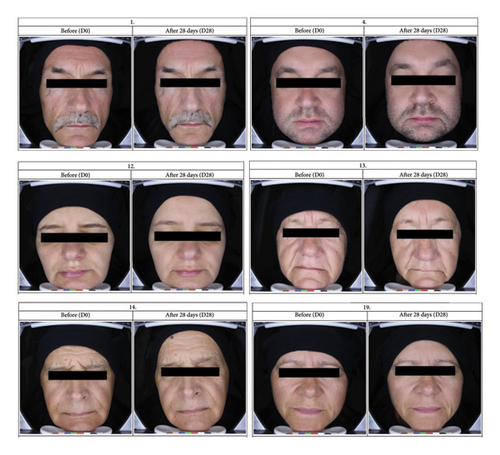
3.3. Instrumental Testing
The levels of skin moisturizing, elasticity, and firmness are presented in Figure 3 and minimal maximal values presented in Table 1. After analyzing the results, we found that, when evaluating the effect of the product on skin moisturizing, all subjects (100%) exhibited positive changes. The results show that 28 days of using night peeling with AA statistically significantly changed the level of skin moisturizing (mean ± SD before: 49.23 ± 12.49 and after: 51.13 ± 12.59 perc.; p < 0.001). Facial skin elasticity also increased significantly (mean ± SD before: 0.75 ± 0.08 and after: 0.83 ± 0.09 perc.; p < 0.001), with 90% of the participants demonstrating positive changes in elasticity. Skin firmness, however, did not change significantly after 28 days of using night peeling with AA (mean ± SD before: 0.18 ± 0.05 and after: 0.17 ± 0.05 perc.; p = 0.352), with a positive effect observed in only 55% of the participants.
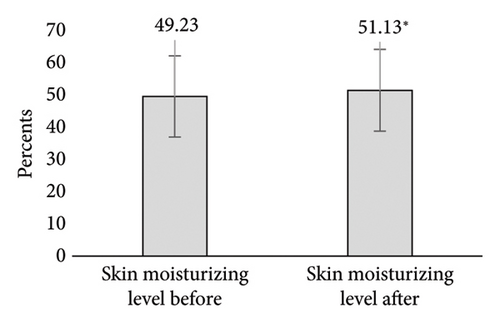
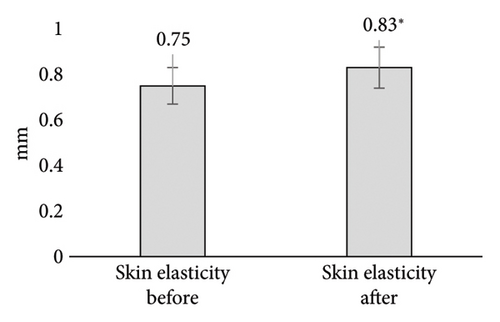
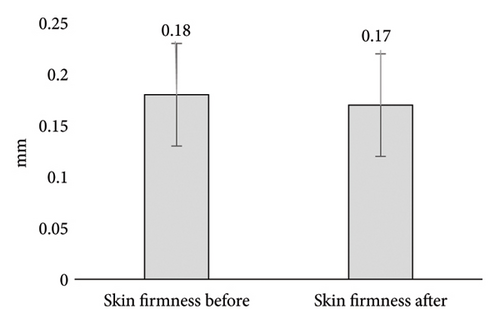
| Indicator | Min; max before | Min; max after |
|---|---|---|
| Skin moisturizing (%) | 26.5; 67.6 | 28.4; 68.5 |
| Skin elasticity (mm) | 0.614; 0.864 | 0.629; 0.966 |
| Skin firmness (mm) | 0.082; 0.248 | 0.090; 0.297 |
| Length of wrinkles (μm) | 103.7; 233.5 | 100.3; 235.0 |
| Depth of wrinkles (μm) | 79.0; 243.3 | 63.5; 223.0 |
| Wrinkle count (μm) | 31.7; 256.7 | 24.0; 215.7 |
| Wrinkle volume (μm) | 7.15; 27.24 | 5.65; 24.85 |
| Wrinkle area (μm) | 73.67; 161.18 | 71.13; 151.70 |
The results of facial skin wrinkle length and depth are shown in Figure 4 and minimal maximal values presented in Table 1. After 28 days of using night peeling with AA, the length of wrinkles statistically significantly decreased (mean ± SD before: 168.55 ± 34.81 and after: 162.55 ± 32 μm; p < 0.001), with a positive effect observed in 86% of the participants. However, this product did not have a significant effect on the depth of wrinkles (mean ± SD before: 134.85 ± 44.78 and after: 131.65 ± 43.39 μm; p = 0.08). On the other hand, it was observed that 64% of the respondents experienced a positive effect on wrinkle depth results.
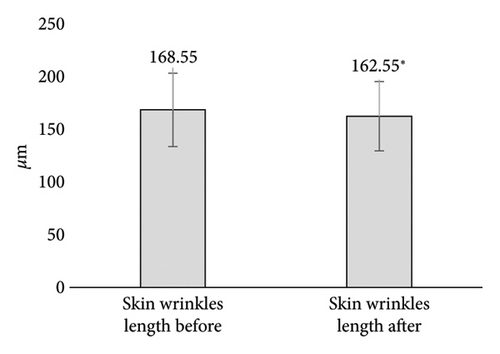
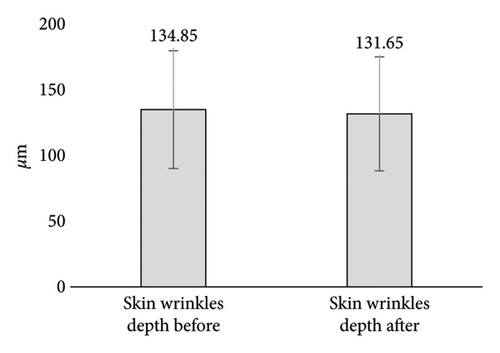
Wrinkle count, volume, and area results are presented in Figure 5 and minimal maximal values presented in Table 1. After 28 days of using night peeling with AA, the wrinkle count decreased significantly (mean ± SD before: 159.65 ± 59.51 and after: 136.0 ± 50.92 μm; p < 0.001), with a positive effect observed in all participants. A statistically significant decrease was also noted in wrinkle volume (mean ± SD before: 15.15 ± 6.63 and after: 13.95 ± 5.98 μm; p < 0.001), with a positive effect observed in 73% of the participants. In addition, the wrinkle area (mean ± SD before: 109.68 ± 22.21 and after: 103.72 ± 21.65 μm; p < 0.001) showed improvement after using of the AA product. Analyzing wrinkle area, a positive effect was achieved in 95% of the participants.
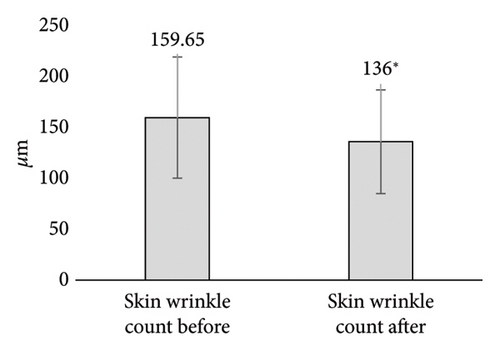
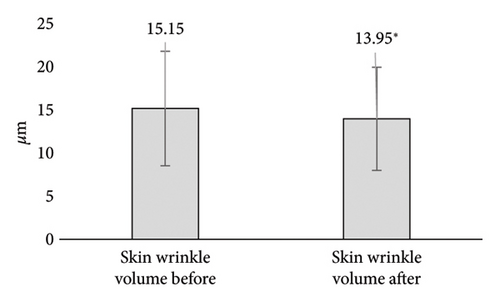
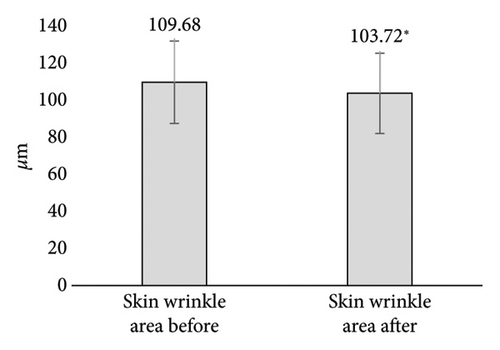
4. Discussion
The aim of this study was to determine the effect of night peeling with AA on the parameters of mature facial skin after 28 days of use. The results showed a moderate increase in skin moisturizing levels by 4%, an 11% improvement in skin elasticity, and a slight improvement in skin firmness by 2%. In addition, AA reduced the wrinkle length (average 4%) and depth (average 3%), along with a decrease in wrinkle count (average 15%), volume (average 8%), and area (average 5%). These results indicate successful compliance with the tested night peeling containing AA. The devices measure very accurately and are sensitive to even the smallest changes. The parameters measured also have certain limits, where there cannot be very large variations as they change by millimeters or even micrometers. Therefore, we consider that these factors could have led to significant changes in some of the parameters.
Despite the improvements in facial skin parameters, AA had no significant effect on skin firmness or wrinkle depth. However, other tested parameters increased significantly. To our knowledge, this is the first study to explore the effects of 28 days of night peeling with AA on skin moisture, elasticity, firmness, and wrinkles.
Although AA is primarily used for acne treatment, a few studies have investigated its effects on reducing signs of aging skin. The fundamental difference in those studies is that they focused on hyperpigmentation, erythema, and telangiectasia. In our study, we chose to analyze indicators that more closely reflect the characteristics of mature skin. We believe that most individuals would like to reduce the symptoms analyzed in this study, as looking attractive is important to everyone.
In our study, we used a cosmeceutical product containing 10% AA whereas other studies utilized products with 15% and 20% [32] AA. As noted by Tetali and colleagues, most cosmeceutical products contain 10% AA, like our study [33]. These results suggest that 10% AA in a cosmetic product may be sufficient to achieve visible effects. Kumar and Rao conducted a study using 20% AA and reported positive effects on skin rejuvenation [15].
AA possesses anti-inflammatory and antibacterial properties and inhibits free radical production, making it a potential method for addressing photoaging effects such as hyperpigmentation although we did not measure this indicator in our study. Tetali and others used a cosmetic product containing AA for 12 weeks and found that it reduced proinflammatory markers, ROS, cathelicidin, and kallikrein 5 factors [33]. In our study, we applied a cosmetic product with 10% AA for 28 days, and our results demonstrated the most noticeable effects on reducing wrinkle count and volume, as well as increasing skin elasticity and moisture. These findings align with those of Khunger and Chanana, who assert that chemical peels are effective for mild and deep static wrinkles [34].
Despite several studies investigating the effects of AA on mature skin, there is limited information regarding the mechanisms by which AA improves wrinkles. We believe that the positive effects on wrinkles may result from the normalization of keratinization processes and seborrhea activity. Another possible mechanism is that chemical peels can modulate epidermal and dermal signs of aging through epidermal thickening and dendrocytic hyperplasia. In addition, peels may stimulate the production of collagen and glycosaminoglycans in both the papillary and reticular dermis, as well as enhance the formation of elastic fibers in the dermis. This mechanism may increase tissue volume, tightening the superficial skin layers and leading to improved wrinkle appearance.
In our study, we observed a moderate increase in skin moisturizing levels and an 11% improvement in skin elasticity. Mazurek and Pierzchała found that skin elasticity improved by 10.7% after 3 months of using AA [35]. Notably, we achieved similar results with the night peel in one third of the time. The increase in elasticity could be attributed to the normalization and rearrangement of elastic and collagen fibers. As previously mentioned, the moderate increase in skin moisturizing levels aligns with the findings of Feng and others, who noted that the hydration effect may be mild due to the hygroscopic properties of AA and its ability to promote cellular renewal [32].
5. Conclusions
Chemical peels remain a popular choice for individuals with mature skin seeking to reduce the signs of aging. While AA is most associated with mitigating photoaging effects such as hyperpigmentation, our study demonstrated that 28 days of night peeling with 10% AA significantly reduced both the number and depth of wrinkles while also enhancing skin elasticity and moisture. Furthermore, the product effectively tightens and lifts the facial skin, promotes regeneration, and provides exceptional softness and noticeable smoothness.
In addition to its antiaging benefits, AA possesses anti-inflammatory and antibacterial properties. As a chemical exfoliant, it gently removes dead skin cells and minimizes the risk of clogged pores. Notably, AA is milder than many other exfoliants, making it suitable for sensitive skin without causing excessive irritation.
The product containing AA was very well tolerated by the participants who completed the study. Throughout the regular application, none reported negative symptoms indicative of intolerance, such as irritation, burning sensation, redness, or itching. In addition, the product did not cause dryness at the application site in any subject.
This study may pave the way for further research into various treatment approaches and the biomolecular mechanisms underlying their effects on skin structures. Future investigations could also explore preventive measures, with the next phase potentially focusing on the development of more targeted treatment strategies, such as personalized therapy protocols that consider patients’ genetic backgrounds and skin-type characteristics.
Ethics Statement
Regulation of the Committee on Compliance with Research Ethics of St. Ignatius of Loyola College approved on the Resolution of Academic Council, no. 2, 5 of January 2021.
Conflicts of Interest
The authors declare no conflicts of interest.
Funding
No funding was received for this manuscript.
Open Research
Data Availability Statement
The data that support the findings of this study are available from the corresponding author upon reasonable request.



